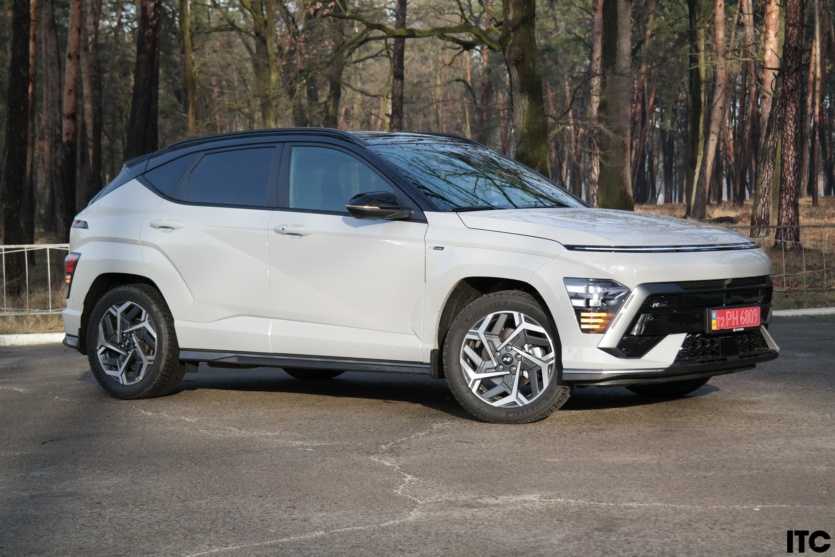
Another compact crossover, but no less interesting because of it. First, it’s a popular brand and a well-known model that was originally designed for demanding customers. Secondly, a hybrid powertrain is hidden under the hood, combined with sporty hints of the opium package. Thirdly, there is a choice of several good packages and a wide range of equipment. So, what is the Hyundai Kona N Line crossover? I’ll tell you now.
Content
- 1 Positioning of the Hyundai Kona
- 2 How the Hyundai Kona N Line crossover rides
- 3 Hyundai Kona N Line car technologies
- 4 Hyundai Kona cost and potential rivals
- 5 Hyundai Kona fuel consumption and vehicle maintenance
- 6 Safety of the Hyundai Kona car
- 7 Hyundai Kona N Line test drive results
- 8 The car is provided by Hyundai Motor Ukraine
Positioning of the Hyundai Kona
The Hyundai Kona was first introduced in 2017 and was immediately positioned as a compact crossover for young, active, «advanced» people. Hence, the rather non-standard design, the presence of electric versions in the range and the simultaneous offer of powerful ones. And now, a few years later, we are waiting for a successor. The second-generation Hyundai Kona (codename SX2) appeared in photos at the end of 2022 and was officially presented in 2023, when all the details about the new model were revealed. In general, the idea of the model has not changed: it is a compact youth crossover with many versions and high-tech equipment.
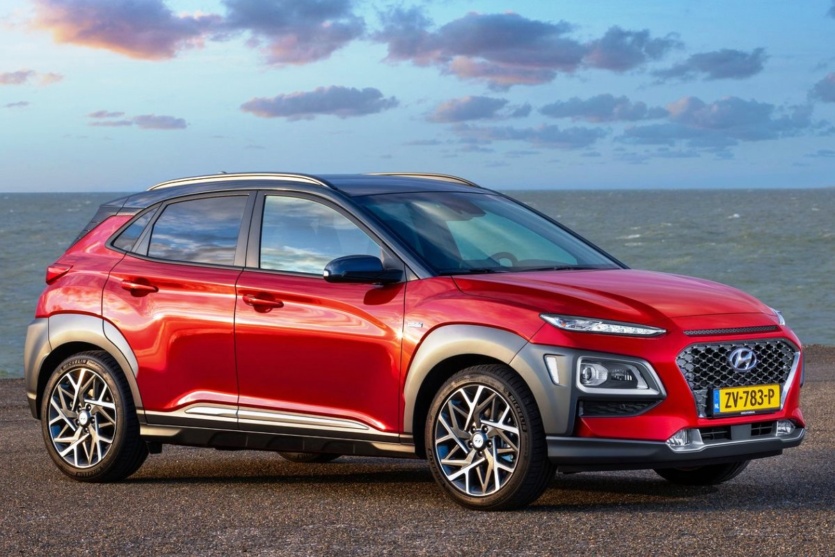
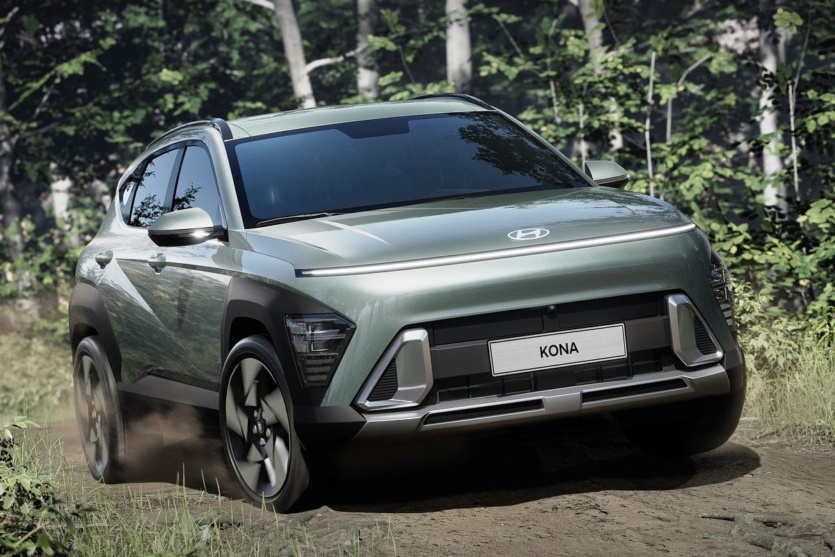
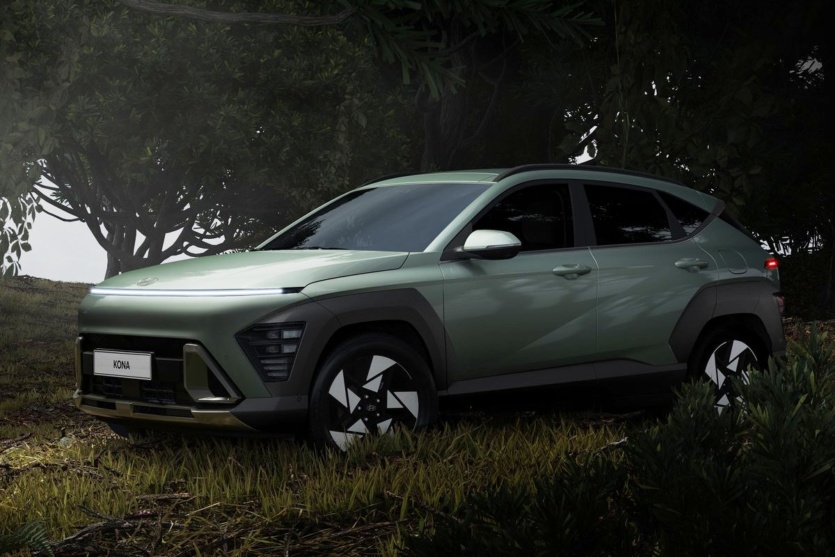
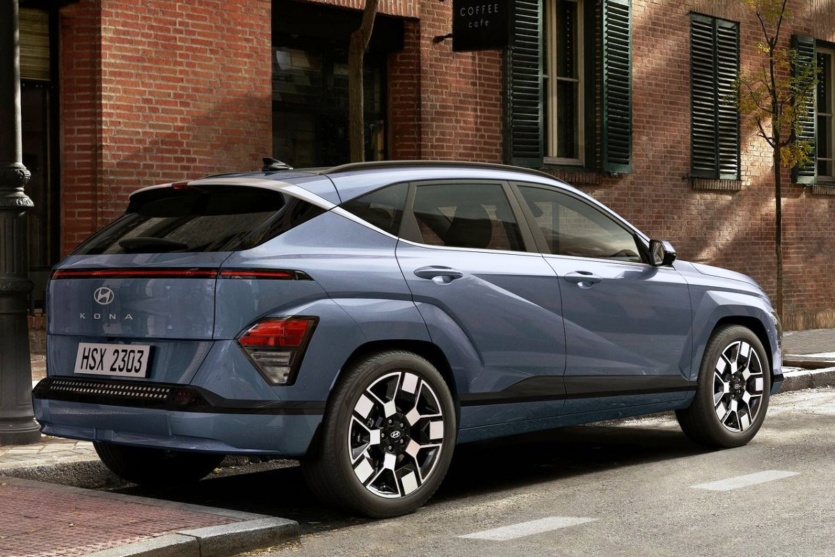
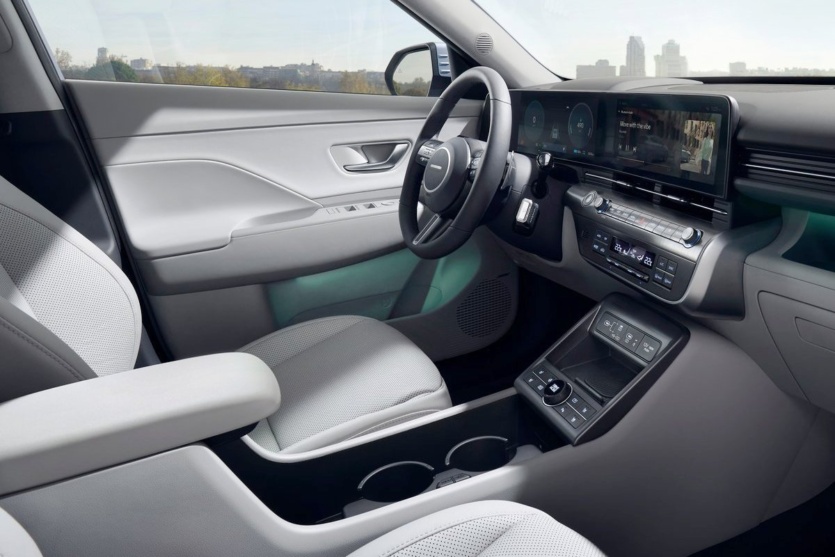
From the first to the second generation — the idea of a car Hyundai Kona has not changed. But the dimensions have changed significantly: if earlier the model Hyundai Kona was located in the very center of the B-SUV segment, today the new model is almost the largest in the segment (4.35-4.39 m); for understanding, the length is at the level of the first Hyundai Tucson! As before, the car Hyundai Kona will be offered in different markets with traditional gasoline engines, as a hybrid or an electric vehicle. Currently, we are getting acquainted with the hybrid version of the Hyundai Kona in the performance of N Line.
How the Hyundai Kona N Line crossover rides
Everything can be summarized in one word, and that word is convenience. For example, the hybrid works perfectly: it provides sufficient dynamics for acceleration in real city life, enough power on the highway when driving at the permitted speeds. There are no noticeable shifts between the two motors (gasoline and electric), and gear changes are also imperceptible. Yes, yes, there is a traditional gearbox in the design — I’ll tell you in detail below, but for now, the fact is important: several mechanisms are perfectly combined into one hybrid whole.
The hybrid also has a wide range of control options. For example, the DRIVE MODE switch provides three driving modes. The standard mode is usually the ECO mode, but even in this mode, there are no unpleasant pauses during acceleration or a feeling of insufficient dynamics. Instead, there are opportunities to customize the regeneration thanks to the «plus or minus» paddles under the steering wheel: you can choose one of three regeneration levels, automatic regeneration mode, or even hold down «minus» and get the maximum possible regeneration from deceleration to full braking. At the same time, the SPORT mode changes the settings of the hybrid powertrain (it now responds more actively to the accelerator pedal), switches the instrument panel to red and black. It also affects the logic of the paddles — they are now responsible for gear shifting. Plus the SNOW mode for slippery winter roads.
By the way, no matter how you switch modes — ECO or SPORT — it does not affect the suspension: it is quite soft, perfectly removes small and medium-sized road irregularities. At the same time, the rear independent suspension behaves well: it doesn’t shake the car unnecessarily, even when unloaded, and also provides a good sense of control during sharp maneuvers and turns. However, they are possible only in emergency unforeseen cases when you really need it. After all, the Hyundai Kona, even in the N Line version, does not provoke any dynamic drive at all. The steering wheel makes the standard 2.5 revolutions from stop to stop, it is quite light, the rolls in the turns are moderate — I will never say that this is bad for an ordinary car for every day. But I will say that, just don’t expect the car to transform into a hot sports car just because of the N Line designation. The Hyundai Kona crossover manifests itself in the usual daily trips — but in such modes it shows itself as best!
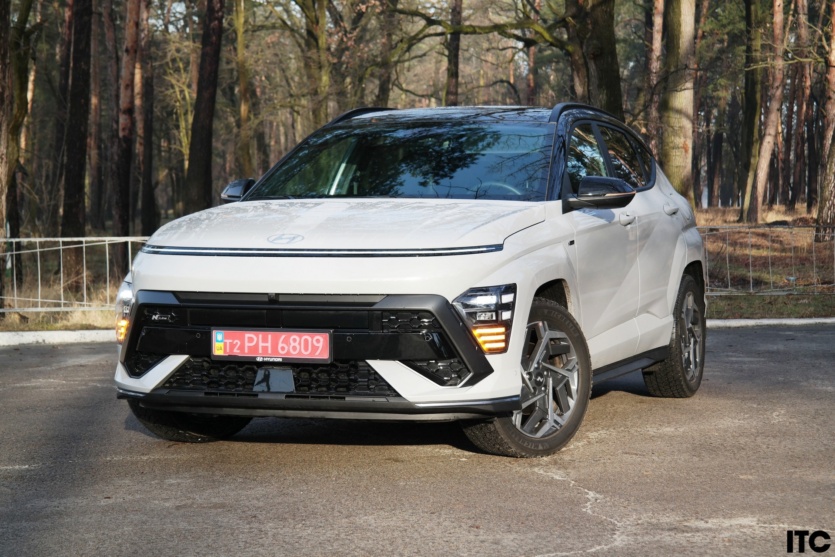

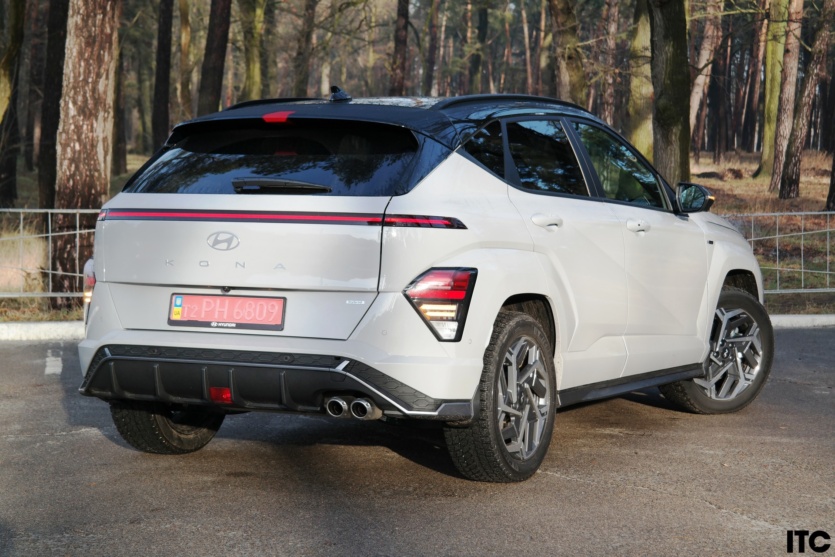
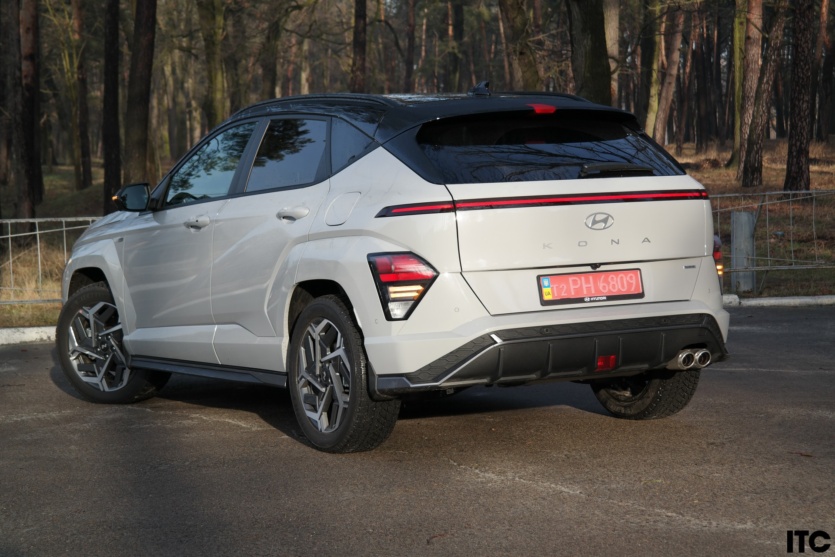
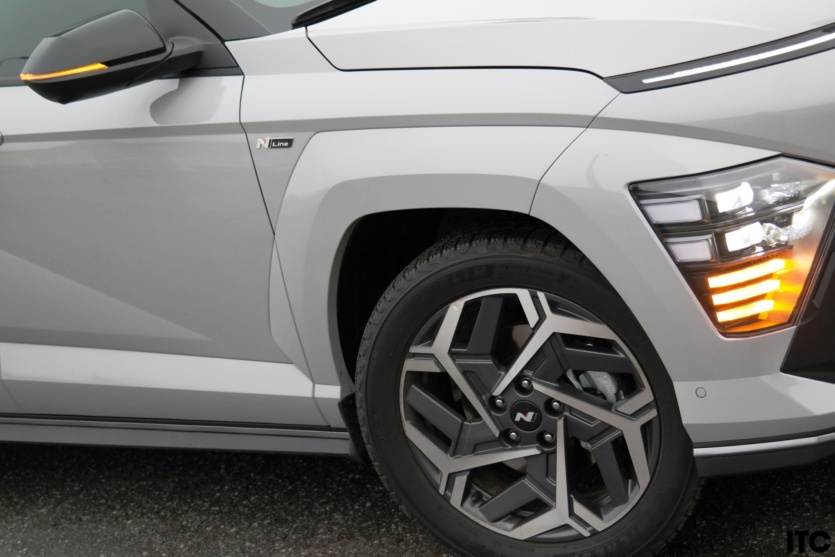
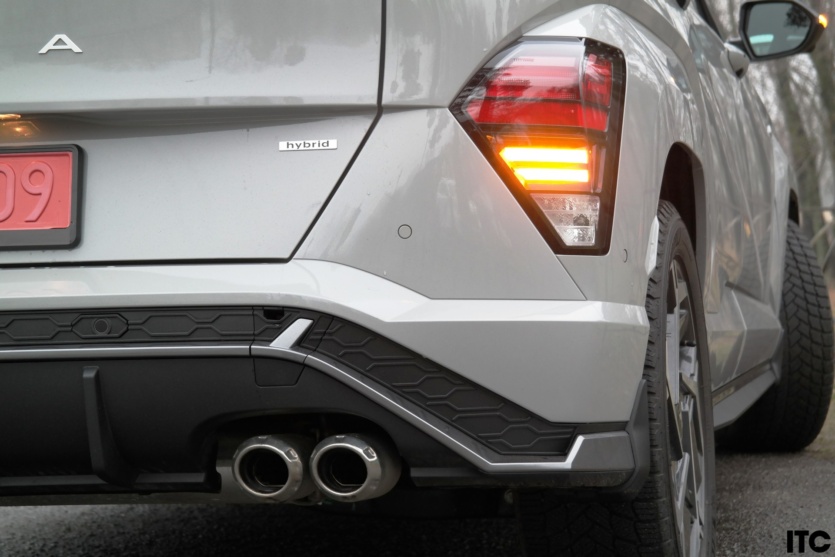
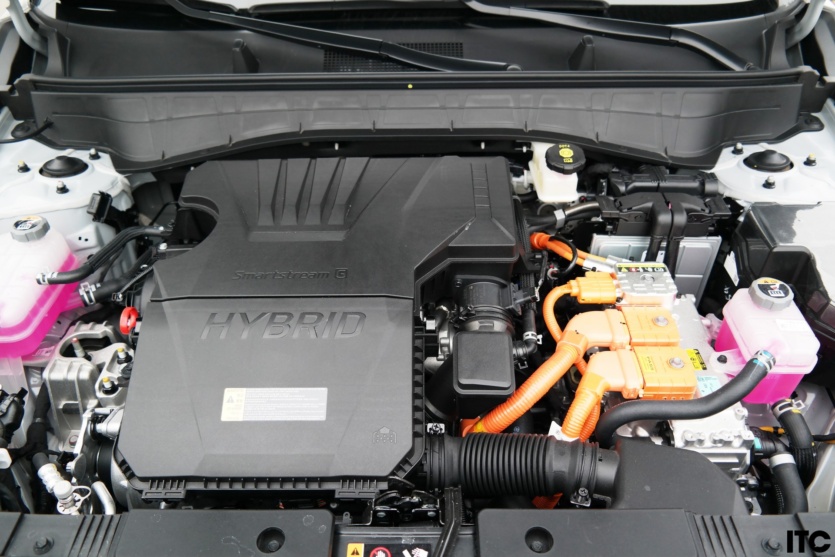
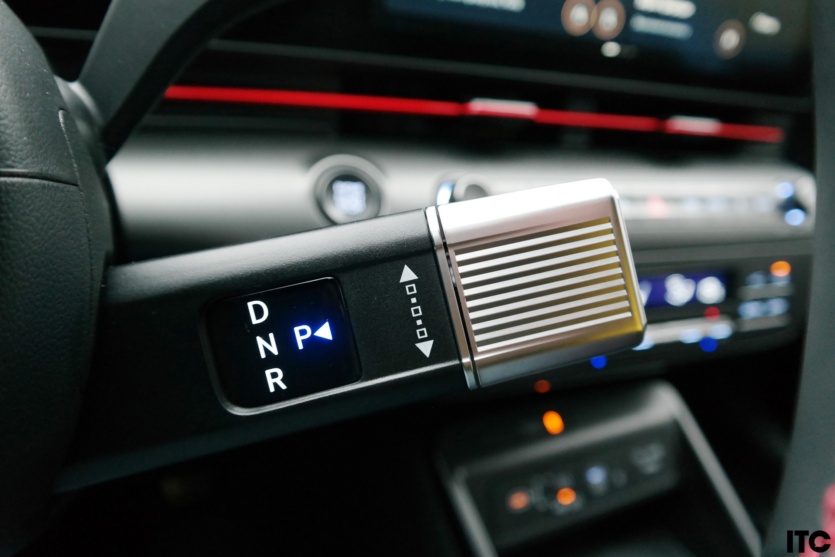
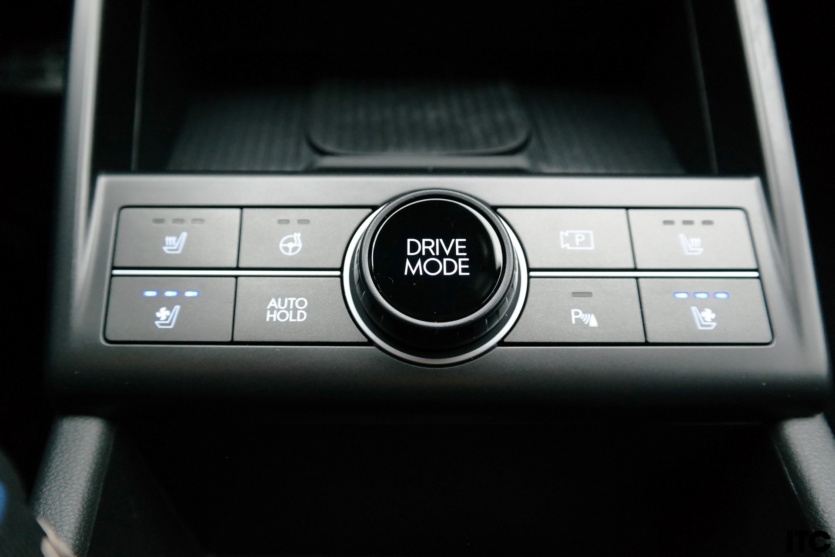
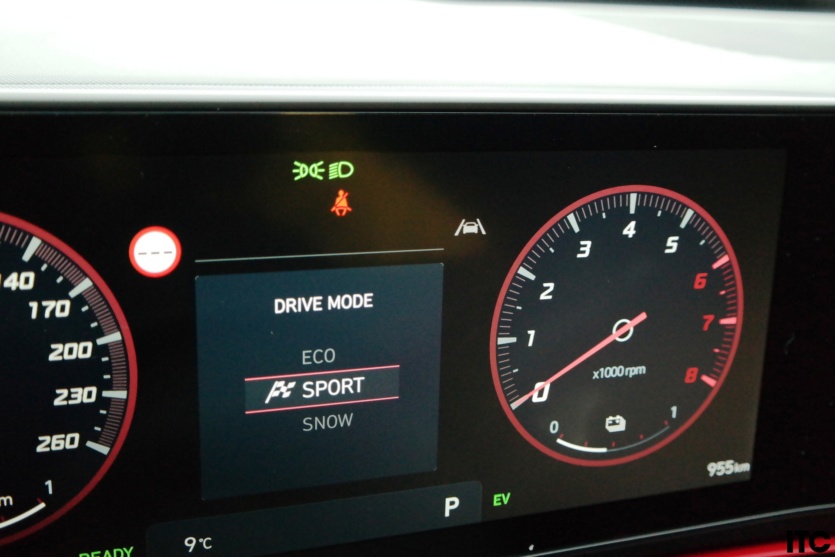
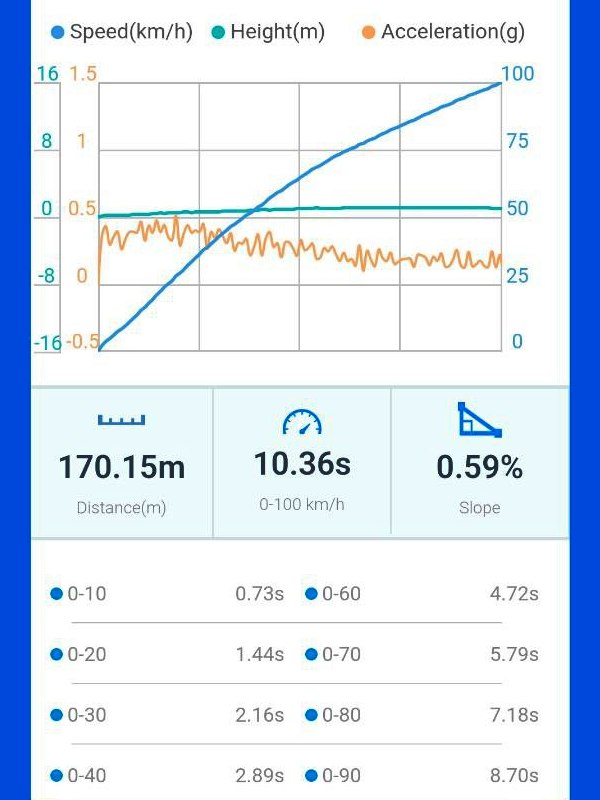
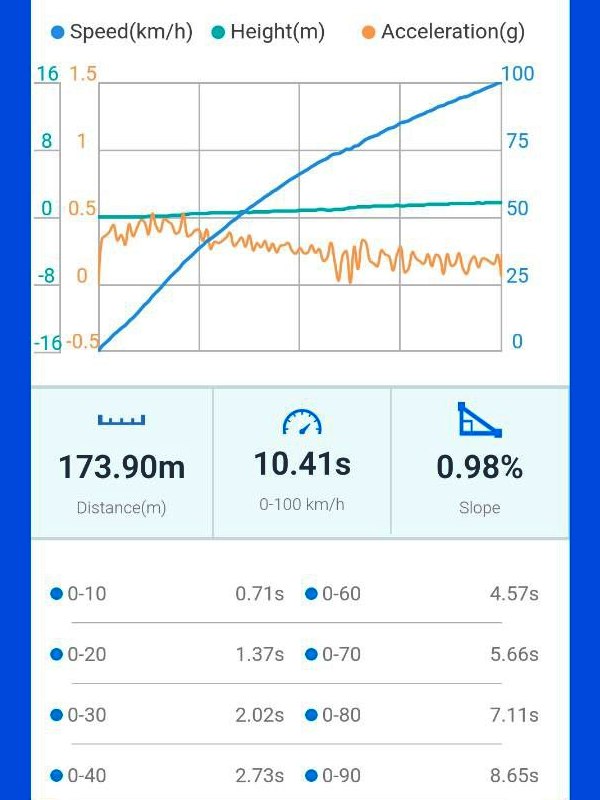
Modern models of Hyundai usually «don’t look great in photos, but turn out to be quite attractive and interesting when you meet them in person. This is a similar case here, especially in the Hyundai Kona N Line: a combination of differently shaped elements (though headlights and lights are «hello» in the event of the slightest accident) is complemented by black decor with sporty hints. In fact, the car’s character is not about sport, but rather about comfort and ease of handling. Acceleration from 0-100 km/h is achieved in 10.3-10.4 seconds: this is not impressive in general, but it is better than the factory specifications, and the process of acceleration control (or deceleration and recovery) is very convenient.
The interior of the Hyundai Kona is also eclectic: a combination of various elements that seem to contradict each other, in fact, creates a single interesting image. Two flat 12.3-inch displays in one horizontal rectangle. Next to them is a fabric insert and red decor. Under the steering wheel is an unusual «automatic» switch. There are also several divided blocks with many buttons and even larger niches for things.
However, this interior is also very convenient. For example, the buttons allow you to switch between menu sections or music tracks, and you can even customize your favorite shortcut keys to the functions you need. The «climate» control unit is easy to understand at a glance, plus there is a DRIVER ONLY setting, which means that the climate control works only for the driver. A small niche is equipped with wireless charging, and a large niche is combined with an armrest and can be divided into several compartments. Finally, I’d like to mention the rear seats: there is an average amount of space here, but maximum attention is paid to comfort — ventilation deflectors, adjustable backrest angle, and heated seats.
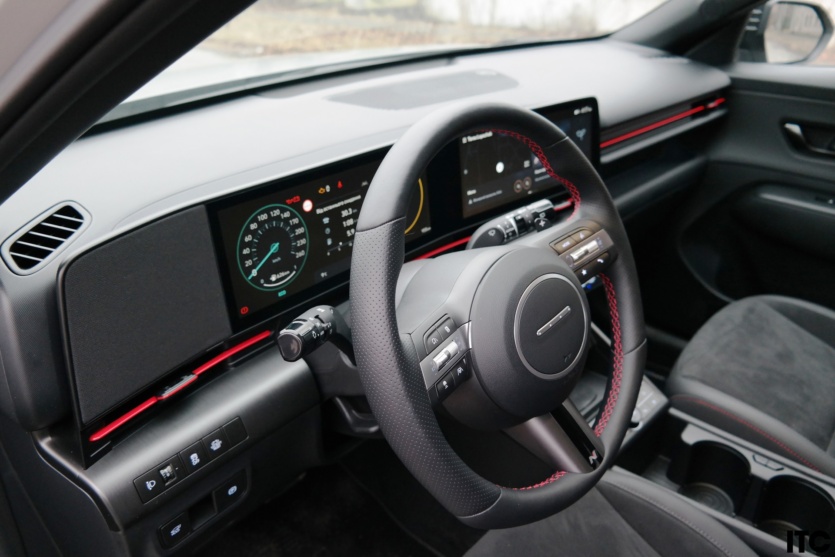
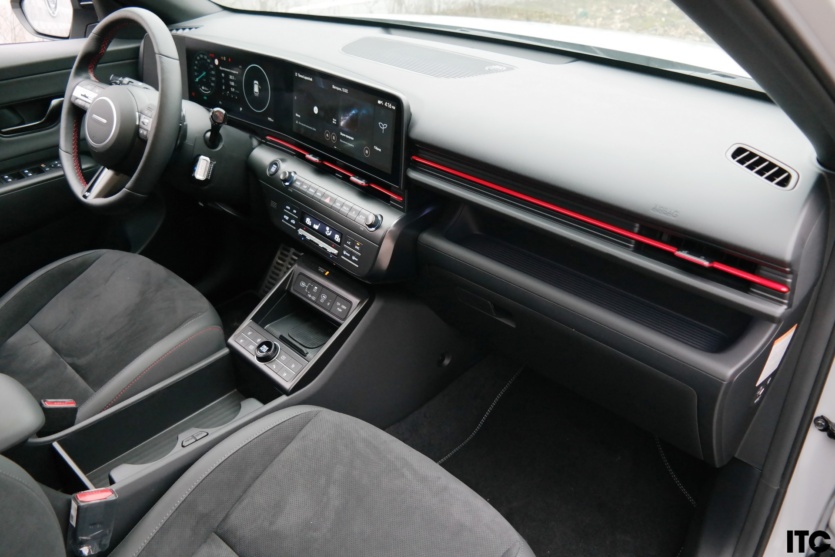
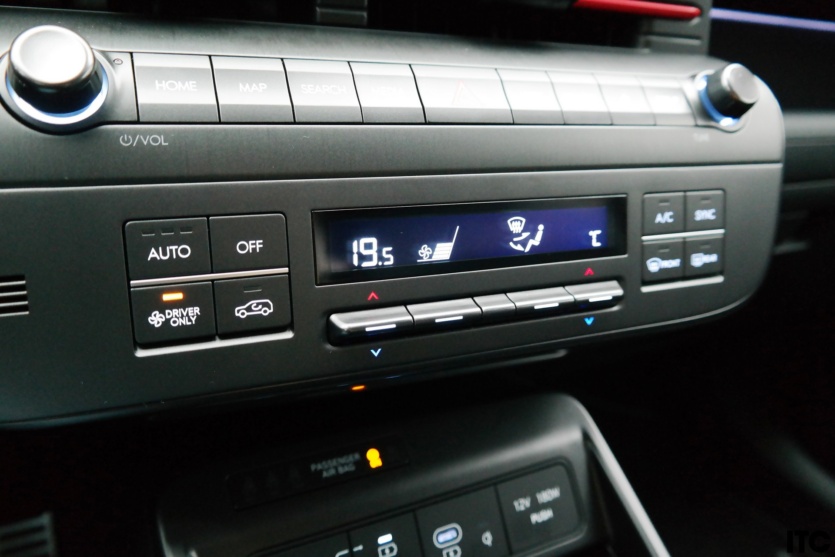
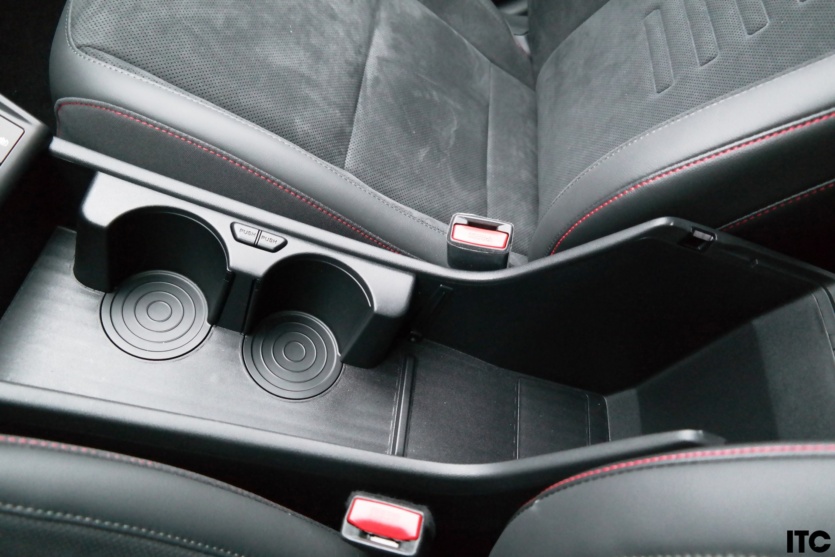
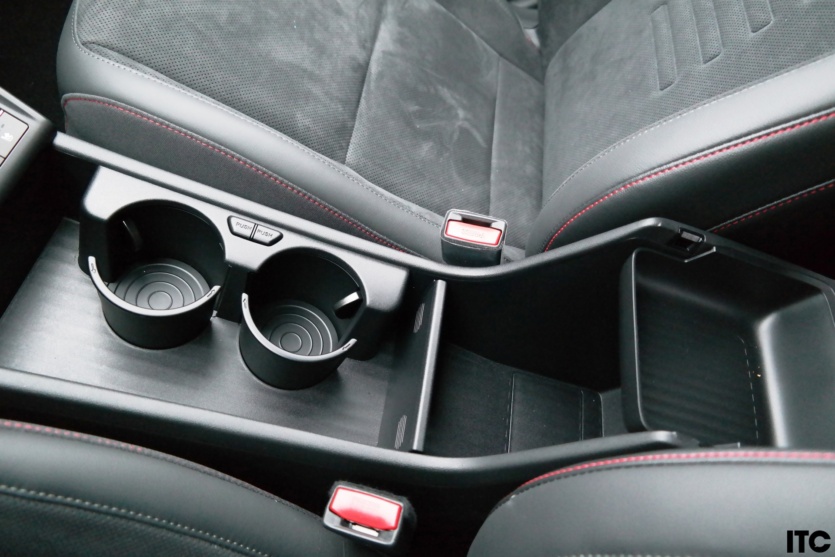

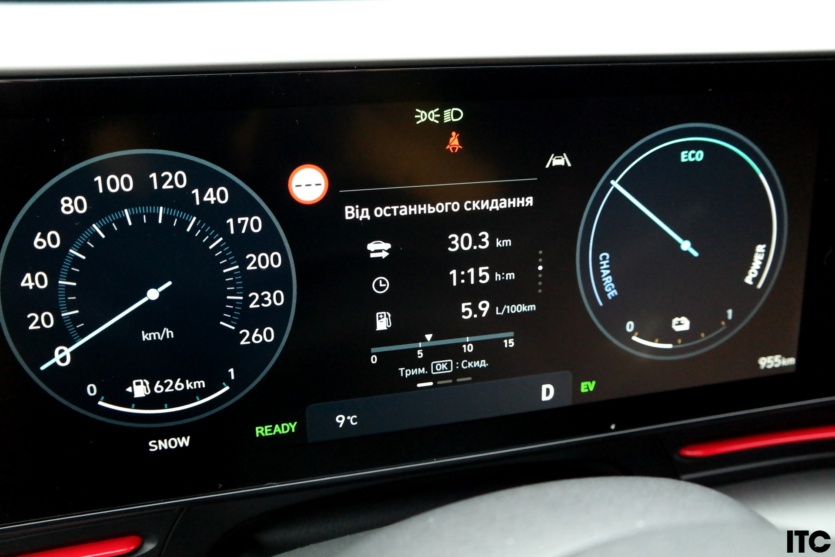
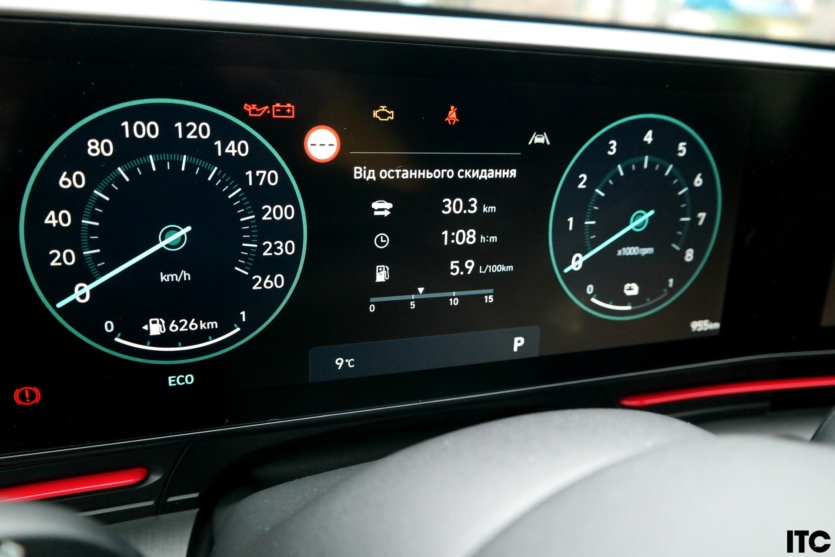
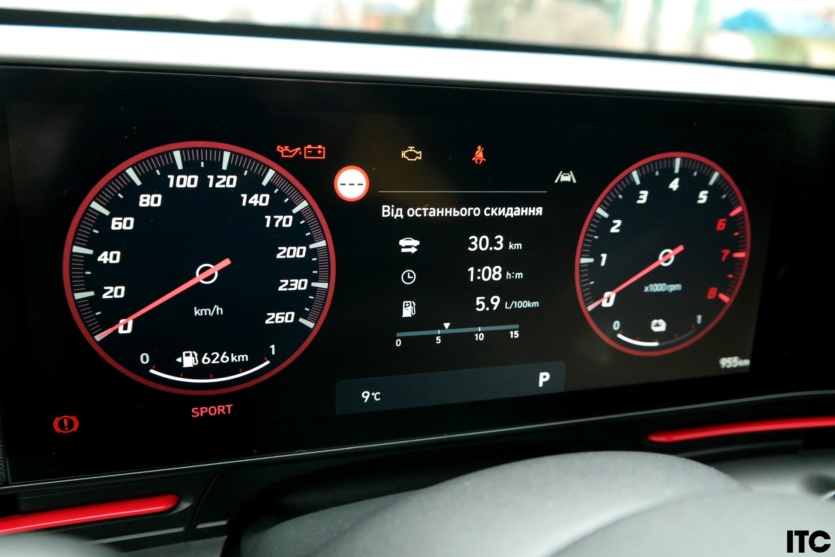

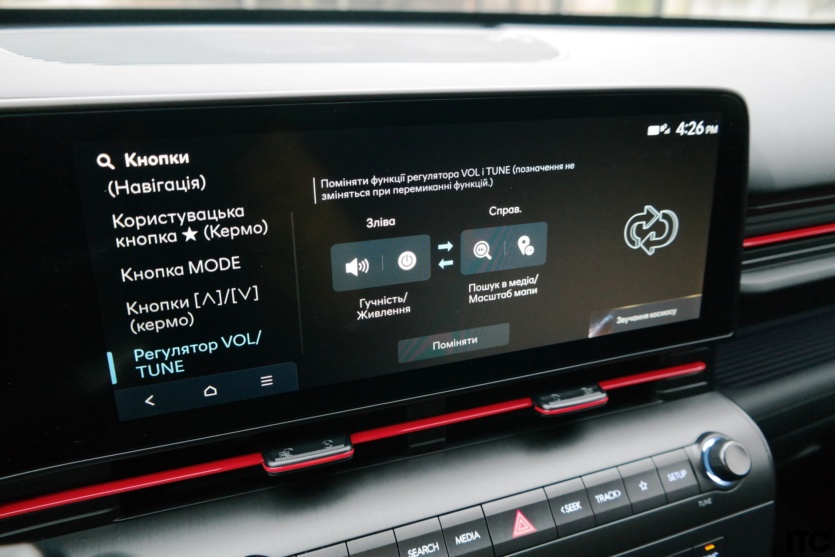
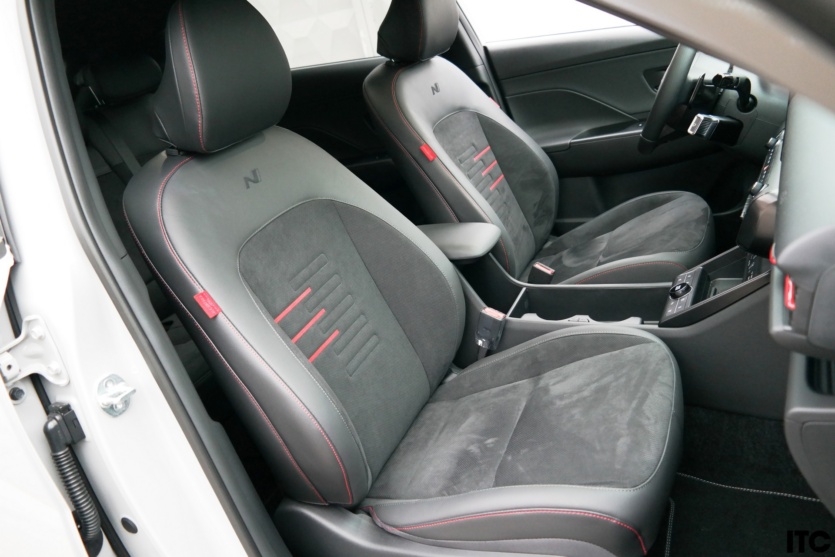
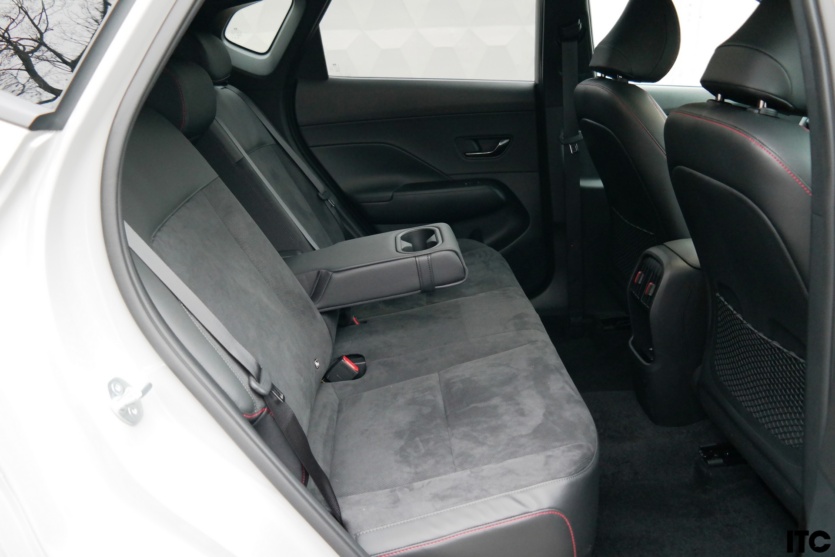
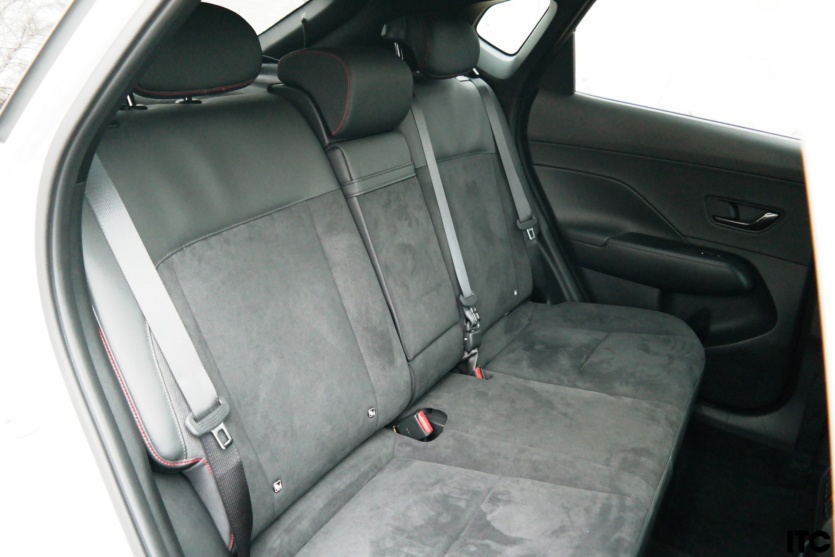
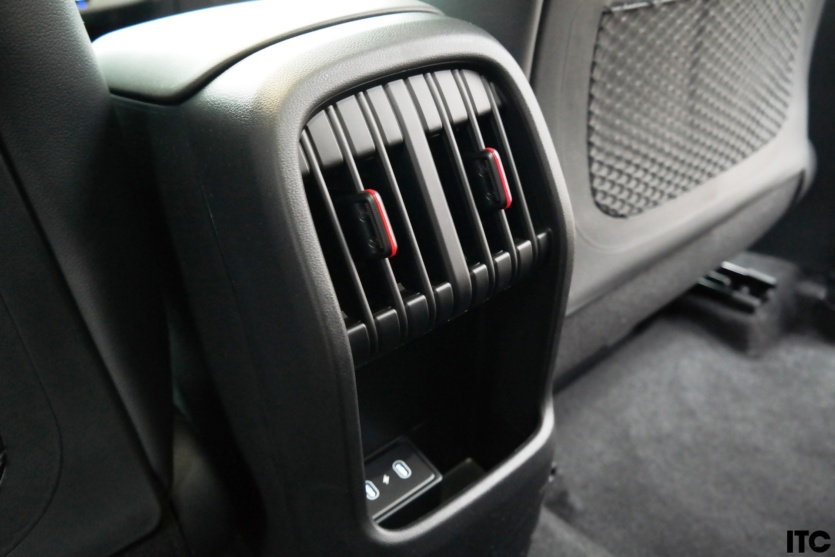
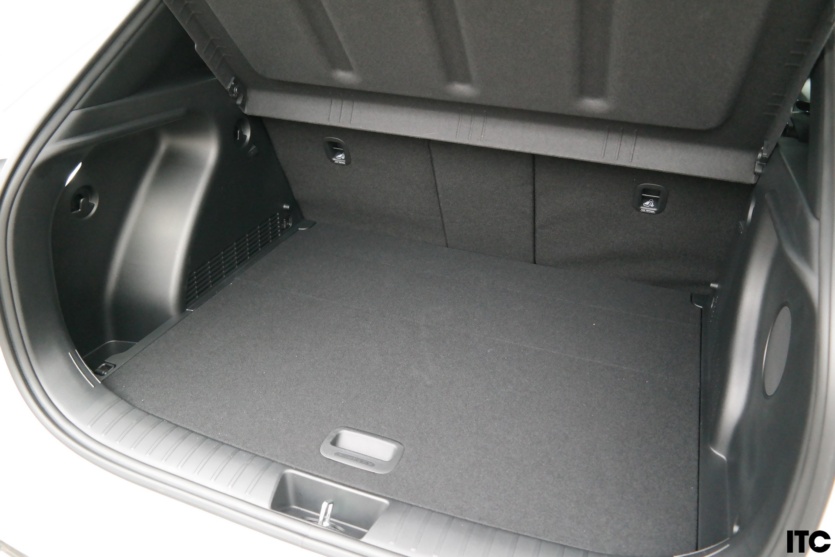
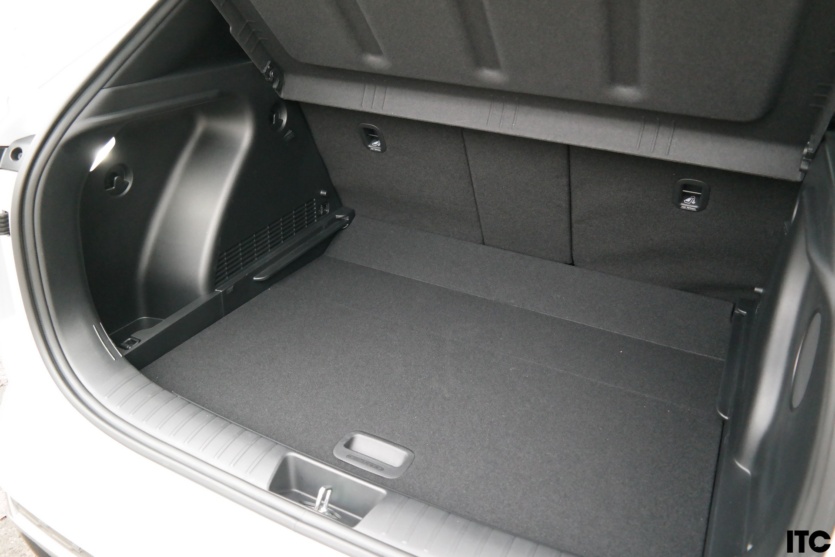
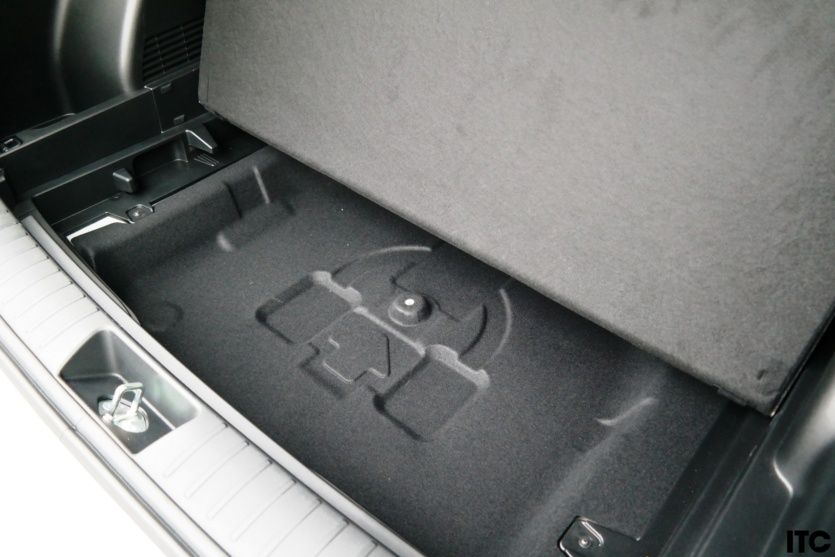
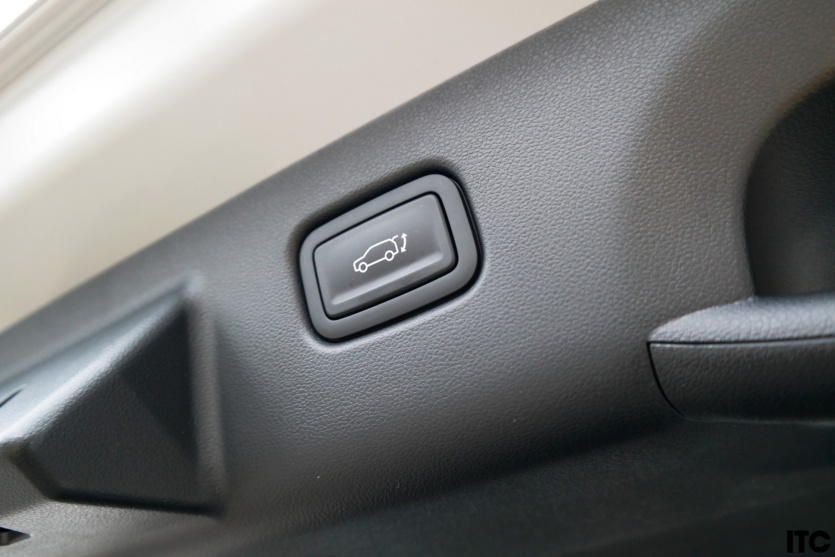
The interior of the «car takes the» not so much in terms of interior space (there is enough space, but nothing more) as in the elaboration of every detail for the convenience and comfort of people. The question is, what happened to the increase in size? It appears that the interior has added only a little space, but the trunk has become much larger: 466–1300 liters, plus a two-level floor and an electric lid.
Hyundai Kona N Line car technologies
The second-generation Hyundai Kona is built on a modular platform with the K3 code designation: a load-bearing body, McPherson front independent suspension, and a front transverse engine arrangement — it seems to be nothing revolutionary. However, it is the rear end that is of interest, which may differ depending on the version of the car: semi-independent or fully independent suspension, the possibility of installing a gearbox to drive the rear wheels or to accommodate a fuel tank and a small battery (for the hybrid version). Even a modified central part of the body to accommodate the battery within the wheelbase (for the electric version).
The model line is opened by Hyundai Kona Express: Front and side airbags, side curtain airbags, center seat airbag, lane departure control, forward collision avoidance assistant, adaptive «cruise», dual-zone climate control, keyless entry and engine start button, heated front seats, NAVI multimedia system with 12.3-inch touchscreen display, rearview camera, LED headlights, 16-inch alloy wheels, etc. The Hyundai Kona Express is equipped with a rearview camera and a rearview camera. The Hyundai Kona Express is equipped with a rearview camera and a rearview camera. Cost Hyundai Kona 1.6 GDI HEV 6AT 2WD Express — from $31.5 thousand.
Next version Hyundai Kona Dynamic additionally offers: Bi-LED headlights, wireless charging, multicolor interior lighting, a digital full-screen 12.3-inch instrument panel, 18-inch alloy wheels, SATIN CHROME decorative trim, etc. Cost Hyundai Kona 1.6 GDI HEV 6AT 2WD Dynamic — from $33 thousand.
One level up is the car Hyundai Kona Elegance with the following added: reverse collision avoidance assistant, «blind spot monitoring» (video monitoring), AVM all-round view, power trunk lid, heated rear seats, combined interior trim (eco-leather and fabric), etc. Cost Hyundai Kona 1.6 GDI HEV 6AT 2WD Elegance — from $35 thousand.
The best option is a car Hyundai Kona Top which is additionally equipped with the following: power front seat adjustment, front seat ventilation, BOSE audio, eco-leather seats, glass tinting, etc. Cost Hyundai Kona 1.6 GDI HEV 6AT 2WD Top — from $36.8 thousand.
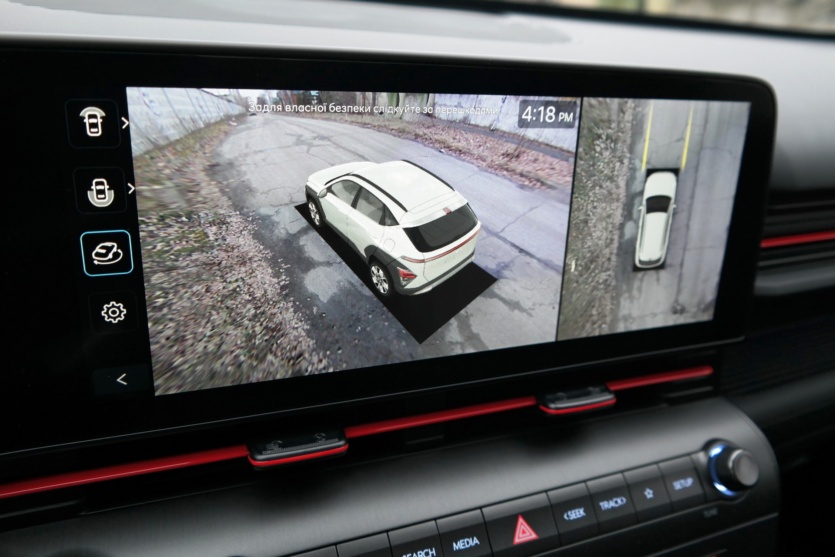
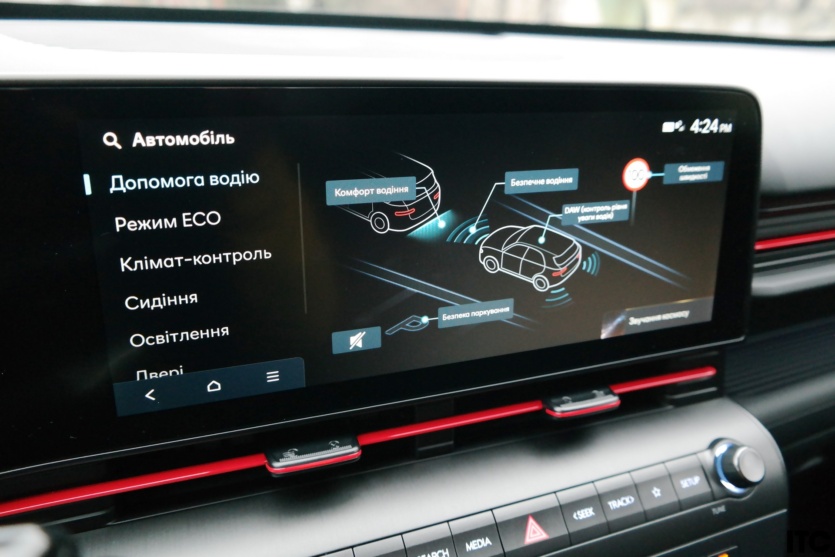
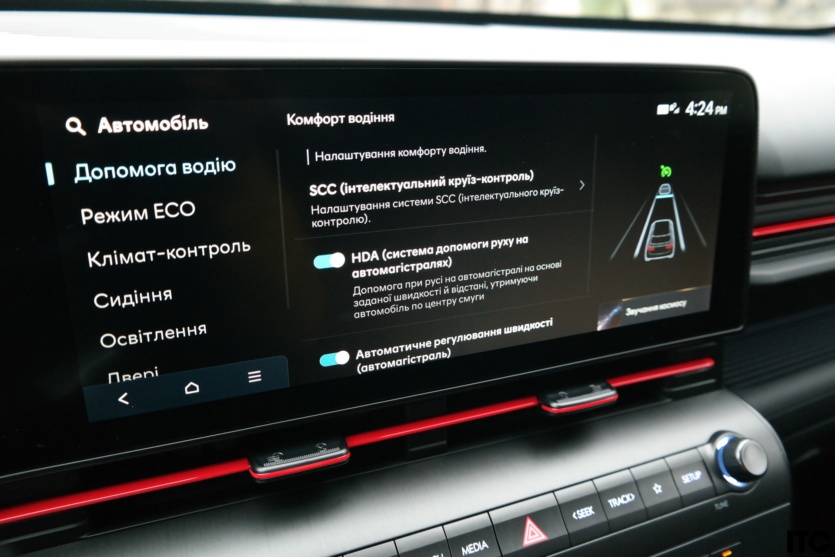
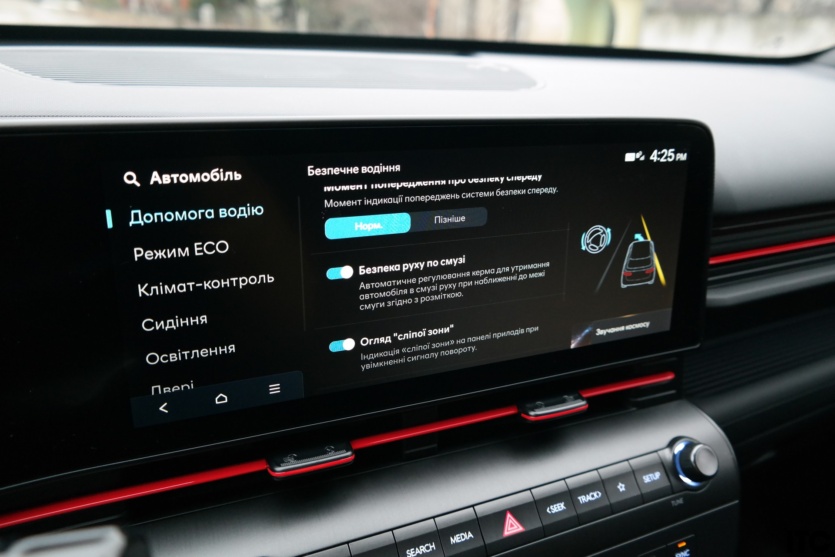
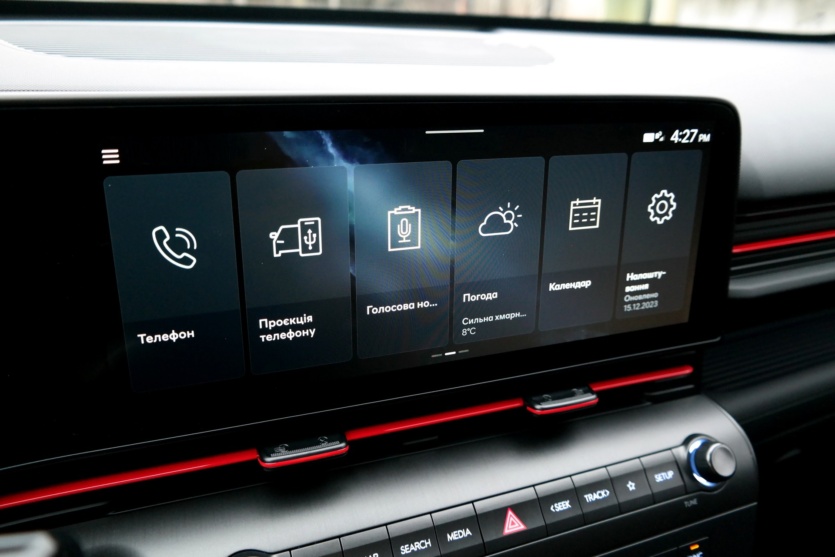
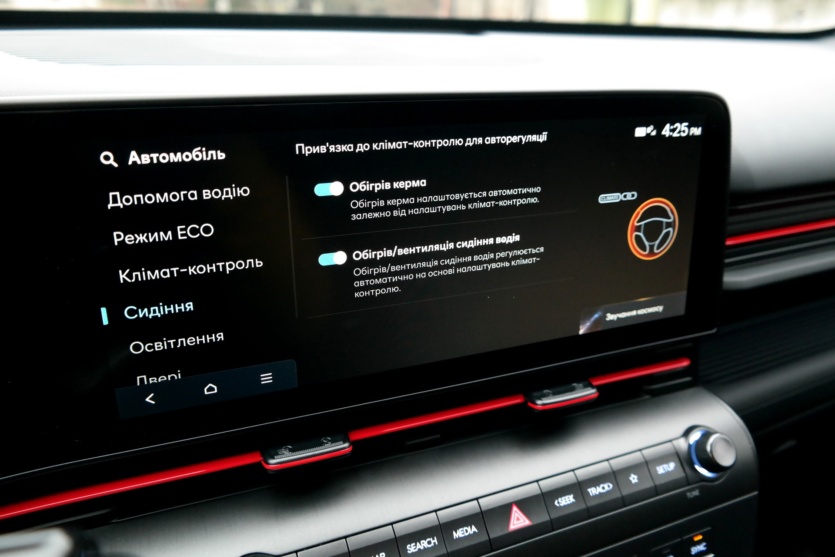
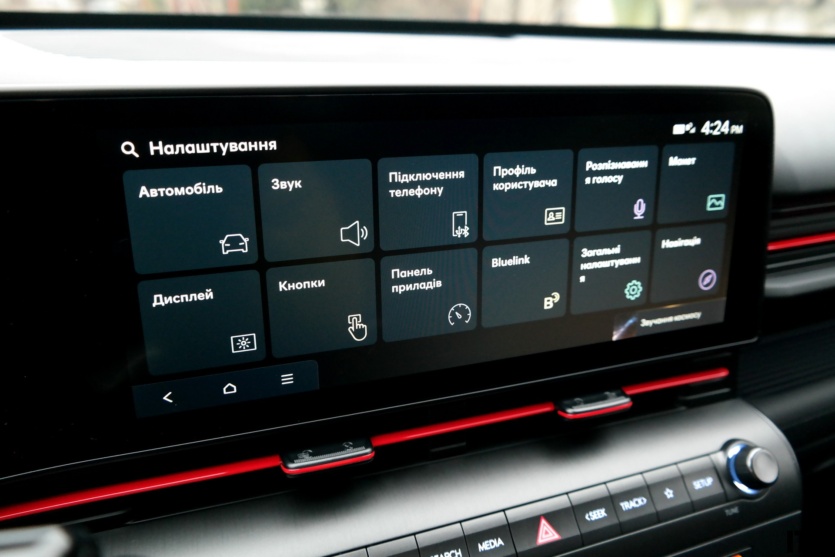
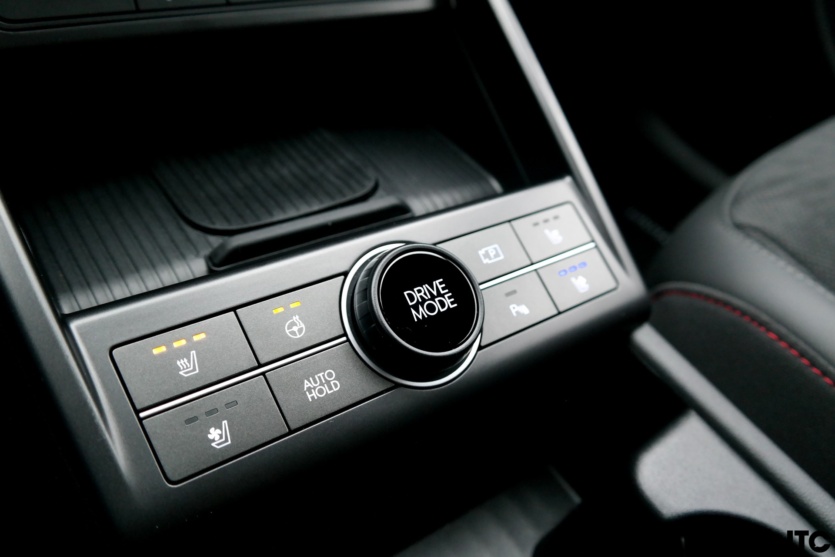
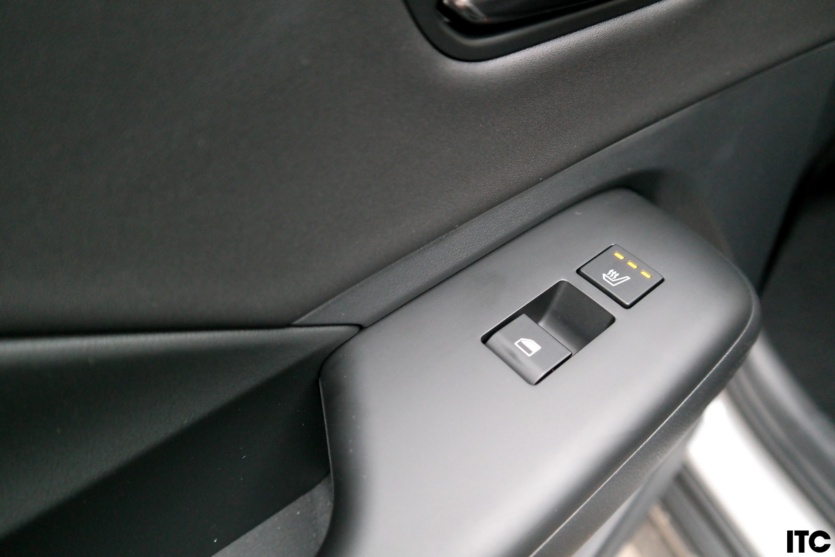
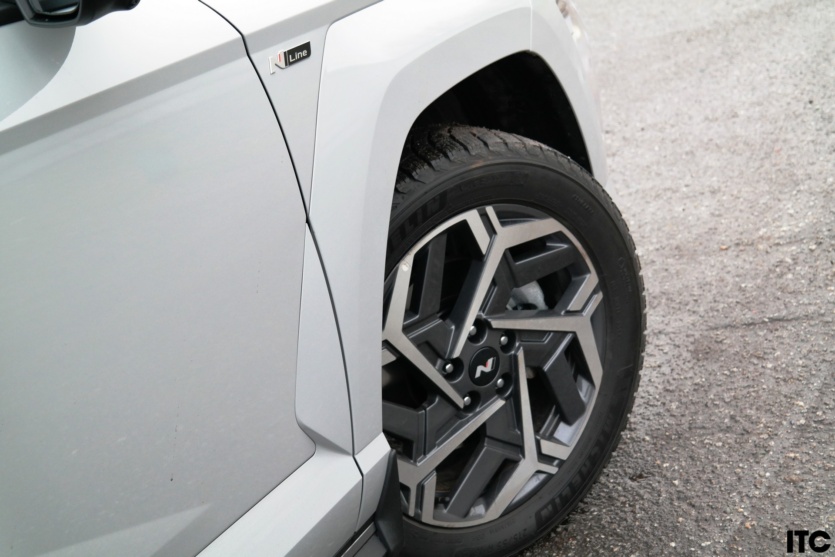
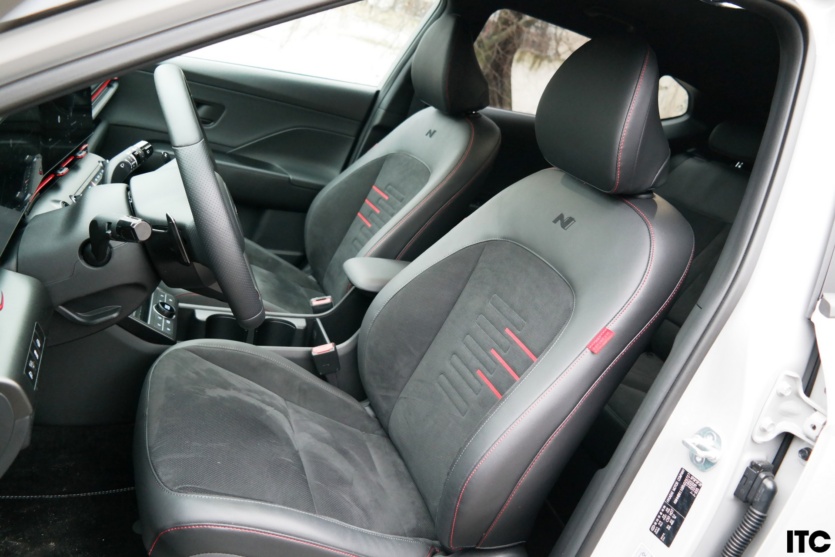
Already in the starting configurations there is adaptive «cruise», separate climate control, and many active safety systems. Higher trims add all-round visibility, video monitoring of «blind spots», heated rear seats, and ventilation of the front seats — this level of equipment is typical for higher-end cars. For the two highest trim levels Elegance or Top the package is offered as an option N Linewhich includes: exclusive wheels, painted wheel arches, black trims, chrome exhaust tips, perforated leather steering wheel, red stitching on the seats, red interior inserts, etc.
Recently, there have been several cars of a similar class with hybrid engines. For example, it is worth noting Jeep Compass: similar price and power, but worse in terms of driving comfort and interior design. I’d also like to mention the crossover Honda ZR-V: іt’s a great ride, more power, but much pricier. However, there is another option from Honda — a smaller crossover Honda НR-V: still a great economic hybrid and a comparable price.
If we don’t focus on hybrids, I’d like to mention a couple of other cars. First, the updated crossover Peugeot 2008: the car is fuel-efficient thanks to a diesel engine, there is also a gasoline engine, and an electric car will soon be available, and there is a wide range of equipment options; at the same time, the price is lower. I would also like to mention the car Volkswagen T-Roc R-Line: a crossover of a similar format and size, only with a gasoline engine, but it drives well and there is a similar version with sporty hints.
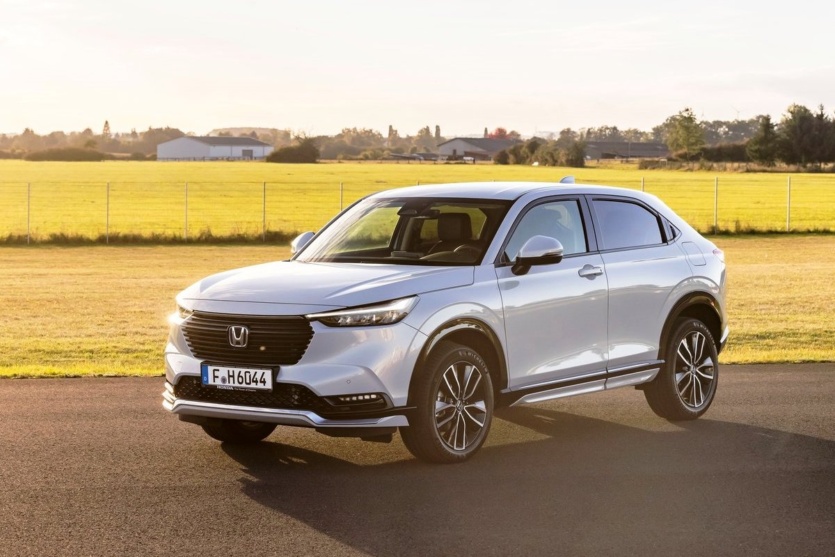
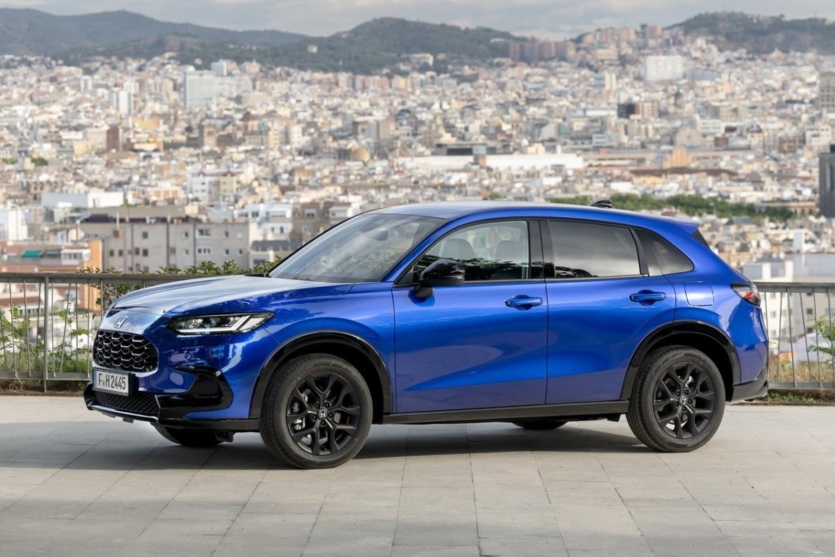
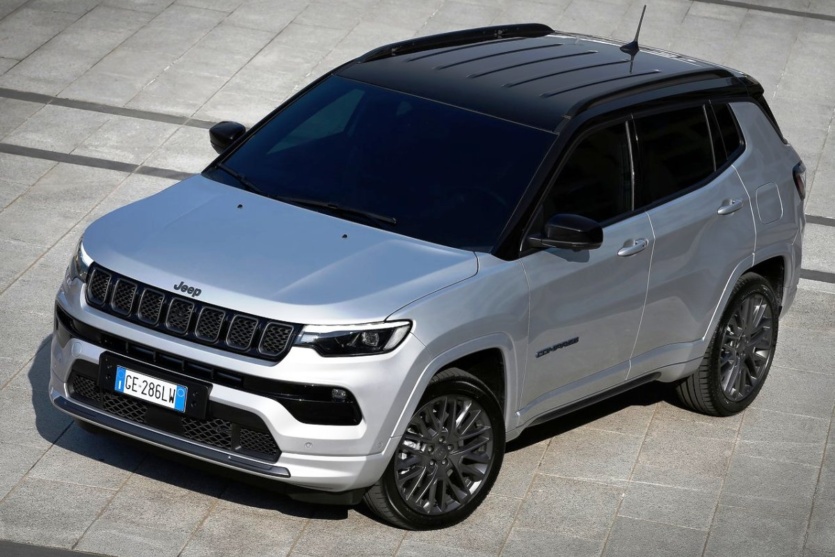

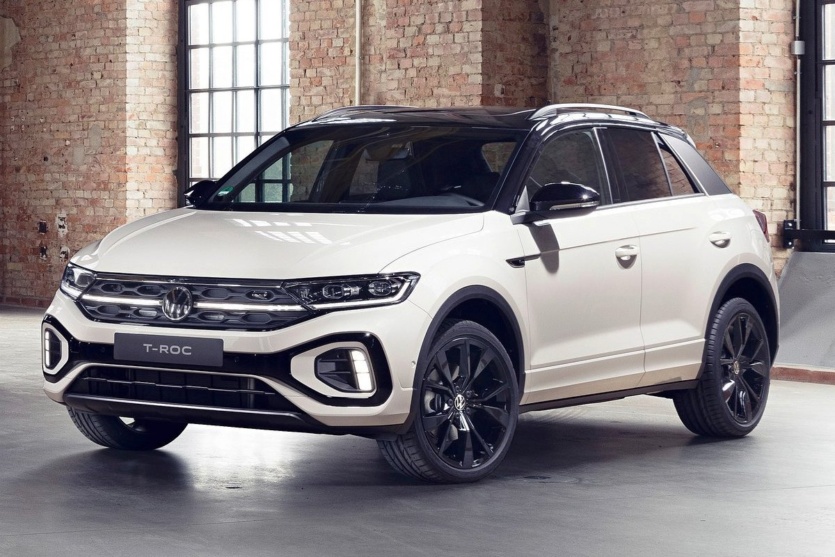
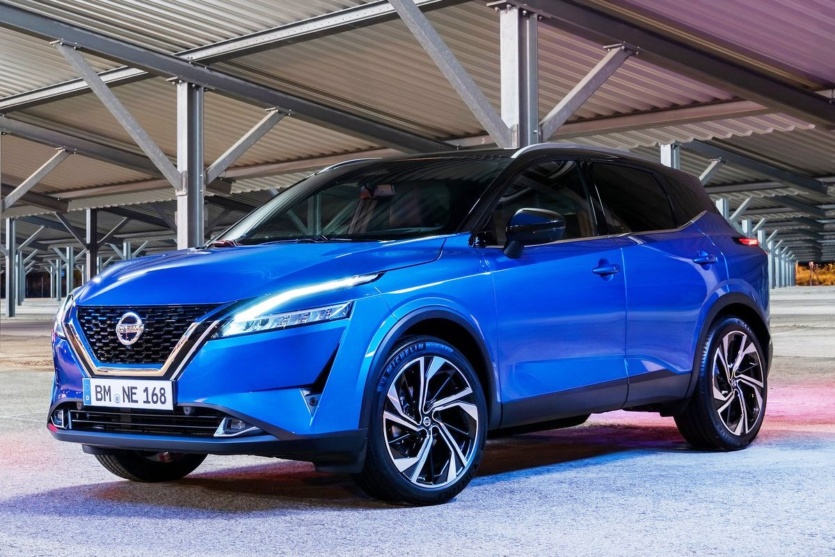
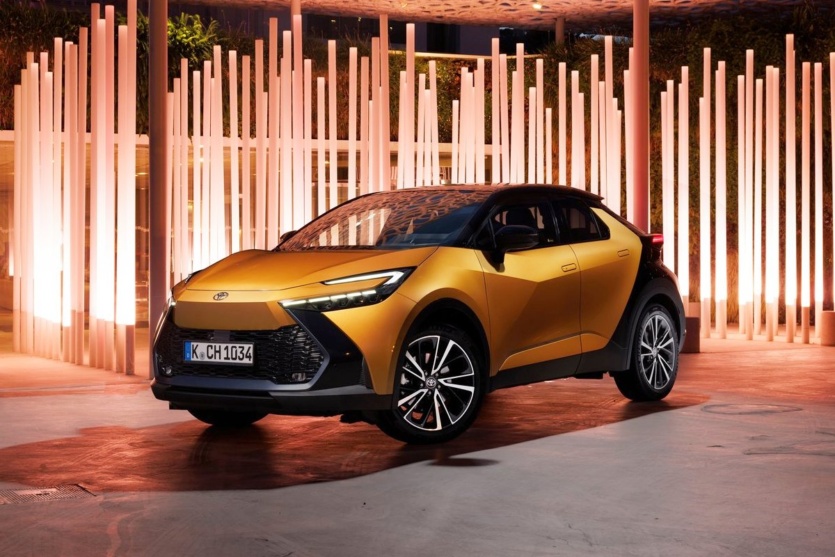
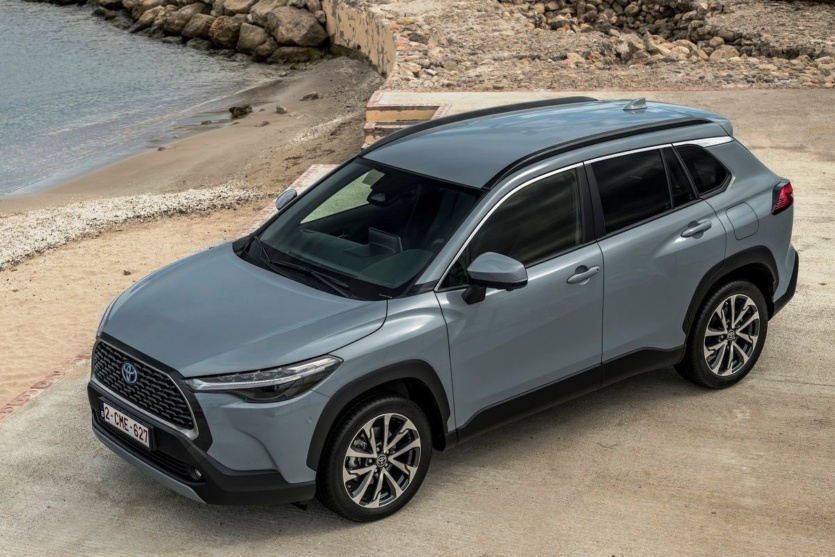
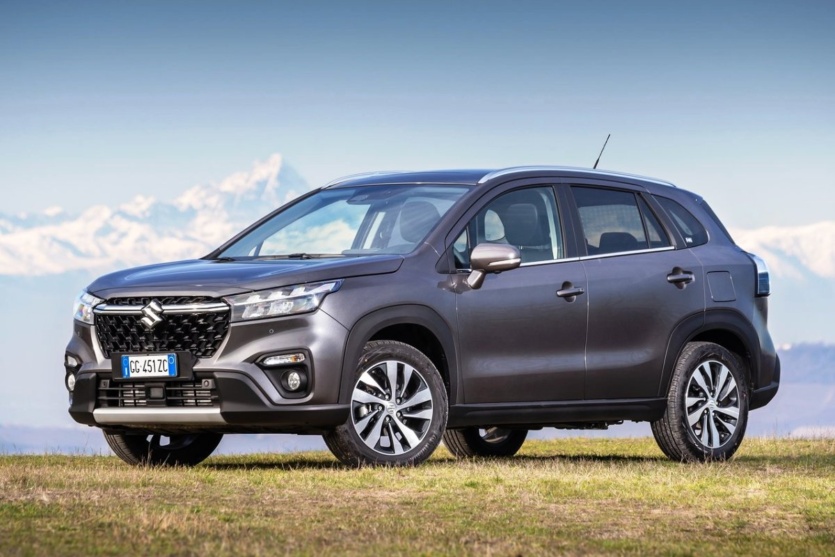
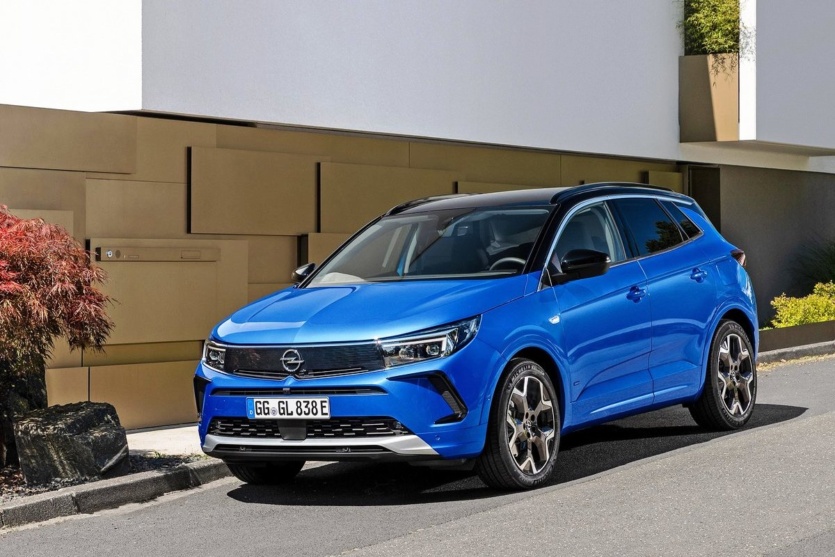

Above, I mentioned only five models for example, but that’s not all. There are several Toyota, Nissan, and Suzuki models (even with all-wheel drive); there are «Europeans» with diesel engines — there are already a dozen rivals.
Hyundai Kona fuel consumption and vehicle maintenance
The Hyundai Kona is currently offered in Ukraine exclusively with a hybrid engine, which also means excellent efficiency in urban conditions — consistently 5.5-6 liters per 100 km, plus or minus 0.5 liters depending on road load (traffic jams or lack thereof). On the highway, the fuel consumption figures will already be familiar to cars of this class: at a speed of 80-90 km/h — an average of 5.5 liters per 100 km; at a speed of 110-120 km/h — about 6.5-7 liters per 100 km.
The general warranty for the car is four years without a mileage limit or five years with a mileage limit of 100 thousand km (whichever comes first). Periodic maintenance (MOT) is required every year or, depending on the mileage. The cost of a simple first MOT is about UAH 12 thousand, while the cost of a more complex and extensive MOT at 60 thousand kilometers is UAH 19.6 thousand.
The cost of the car and MOT is as of March 2024. The cost of maintenance is given for one of the Kyiv dealers and may differ depending on the dealer.
Safety of the Hyundai Kona car
The car passed the Euro NCAP crash test cycle under a new and more stringent program. The car received 80% of the maximum rating for adult safety, although there were many comments: protection of the driver’s torso in frontal impacts, neck protection in rear impacts; but maximum marks for safety in side impacts. Child protection was rated at 83% of the maximum, but the picture is completely unique: almost all indicators have green marks for the highest level of protection. The performance of driver assistance systems and pedestrian safety are rated at 60-64% of the maximum. The overall result is four stars out of five possible.
Hyundai Kona N Line test drive results
Let’s start with the details and move on to the main points. So, about the details: even in the case of the Hyundai Kona N Line, you won’t find a sporty characteristic. There is no super-powerful engine, special large brakes, or rigid suspension to keep the body from rolling. The Hyundai Kona N Line crossover offers only exterior and interior styling, although it is done well. Therefore, emotions should be sought elsewhere. And now to the main point.
The Hyundai Kona crossover is perfectly balanced in general: enough space in the cabin, a good ride, a good economical hybrid. We should also mention the excellent equipment – here Hyundai Kona is not just among the best, but may even lead the group of leaders. Therefore, the main emotion from the Hyundai Kona N Line in particular and the Hyundai Kona in general is the emotion of pleasure from operating and using a great «car for everyday». This is where the new Hyundai Kona crossover proves to be the best.
Pros:
+ An incredible list of equipment for cars of this class
+ Good hybrid: enough power, excellent economy, smooth operation
+ Original interior design, very practical and comfortable at the same time
Cons:
– We need to expand the range of versions: simpler and cheaper, more power, all-wheel drive
| Hyundai Kona 1.6 GDI HEV | |
| Body, type | crossover, 5 doors, 5 seats |
| Dimensions (L x W x H) | 4.39 × 1.83 × 1.59 m |
| Wheelbase | 2,66 м |
| Declared clearance | no data |
| Trunk volume | 466-1300 л |
| Minimum curb weight | 1 410 kg |
| Engine | hybrid, 4 cylinder 1.6 liter gasoline plus electric motor |
| Power | 141 hp (total hybrid power) |
| Torque | 265 Nm (total hybrid torque) |
| Specific power and torque | 100 hp per 1 ton and 188 Nm per 1 ton |
| Type of drive | front-wheel drive |
| Transmission type | 6-stage «automaton» (6DCT) |
| Dynamics 0-100 km/h. | 10.9-11.2 seconds (depending on the size of the tires/disks) |
| Maximum speed | 155-165 km/h (depending on the size of the tires/ wheels) |
| Fuel consumption, combined cycle, WLTP | 4.5-4.7 liters per 100 km |
| Minimum cost | from UAH 1.21 million or $31.5 thousand. |




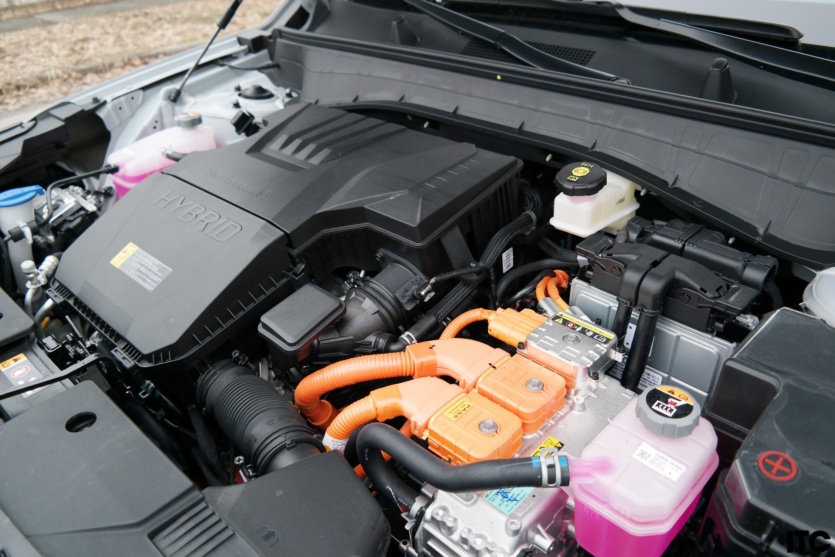
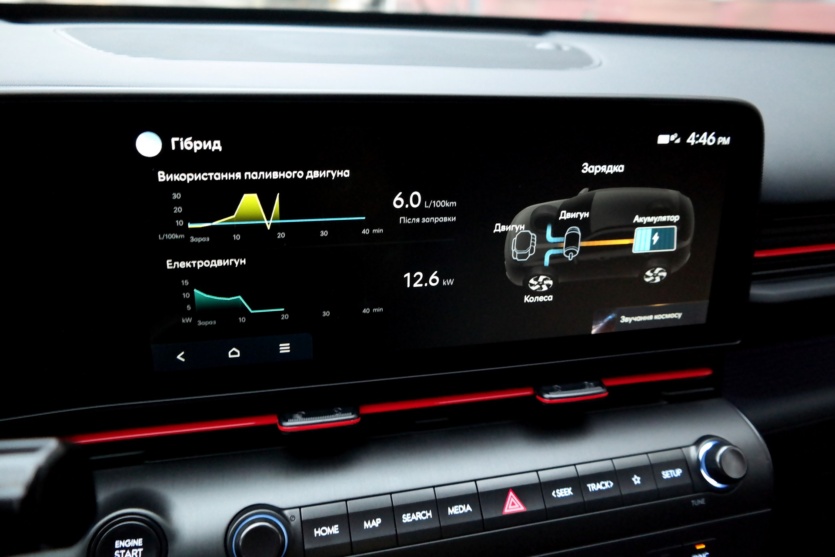
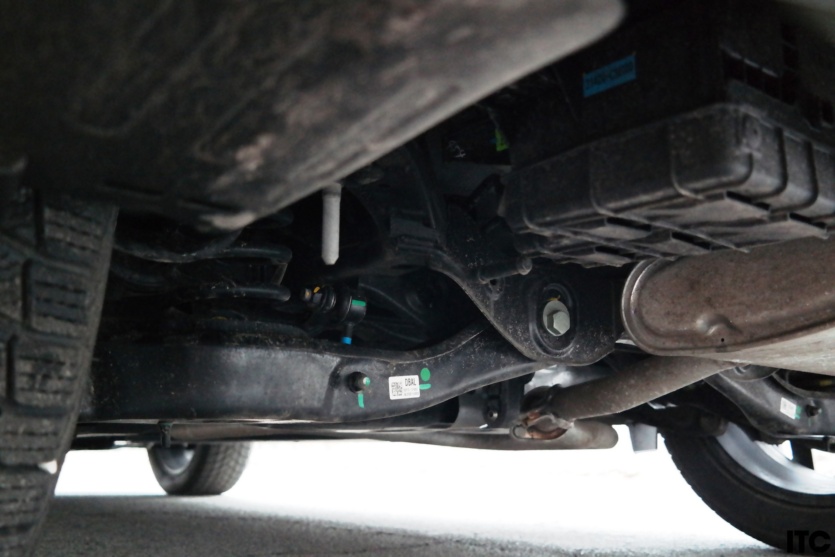
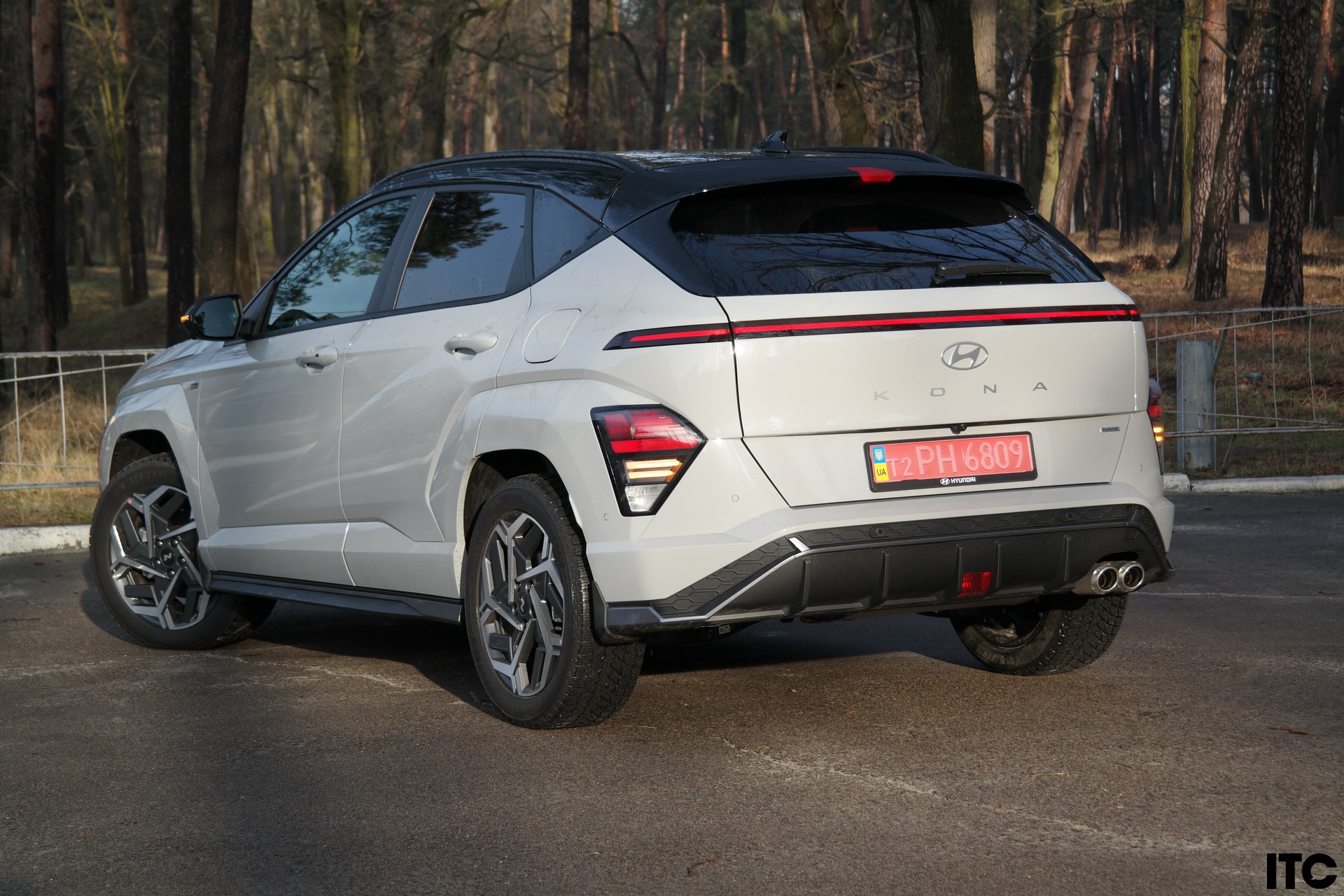
Spelling error report
The following text will be sent to our editors: